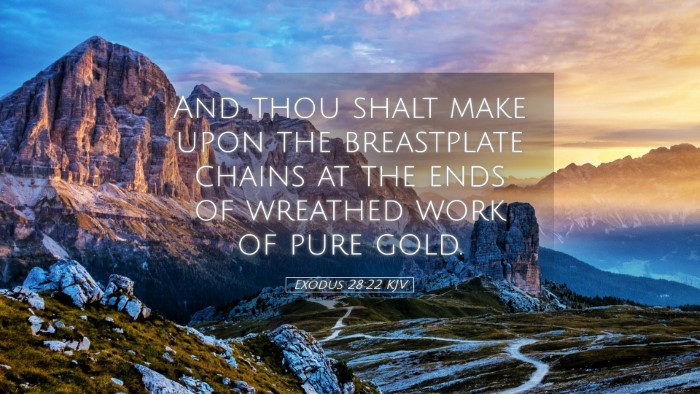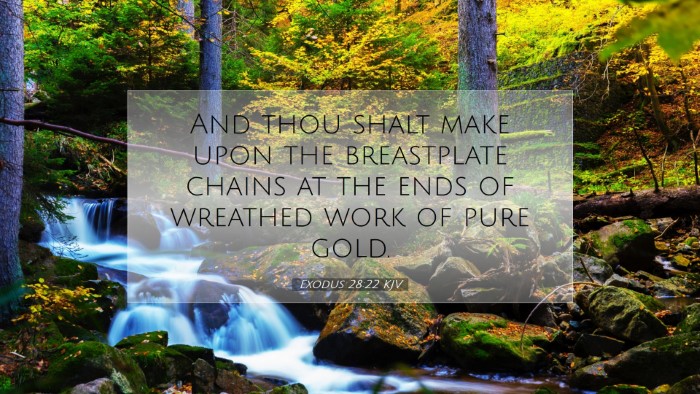Exodus 28:22 Commentary
Exodus 28:22 presents a specific instruction regarding the high priest's garments. In this verse, we encounter the detailed description of the priestly attire, particularly the breastplate of judgment. The verse states:
"And thou shalt make upon the breastplate chains at the ends of wreathen work of pure gold."
This verse is critical to understanding the symbolism and function of the high priest's garments, especially concerning Israel’s spiritual life and worship.
Contextual Analysis
The context of this verse is embedded in the larger narrative of God establishing His covenant with Israel and the Levitical priesthood. Exodus 28 outlines the garments of the high priest, which serve both ceremonial functions and theological significance.
The Role of the High Priest
The high priest was the mediator between God and the people of Israel. According to Matthew Henry, these garments were designed not only for beauty but for capability, representing the gravity of the priest’s responsibilities.
- Representation: The high priest represented the people before God, carrying the names of the tribes of Israel upon his breastplate.
- Intercession: The garments, including the breastplate, symbolized the intercessory role of the priest, as he went into the presence of God bearing the weight of the people's needs.
The Significance of Chains
In this specific verse, the mention of "chains at the ends of wreathen work of pure gold" suggests several layers of meaning:
- Beauty and Craftsmanship: The emphasis on "pure gold" highlights the divine standard expected in items associated with God's worship. Albert Barnes suggests that this reflects both the holiness of God and the inherent worth of the worship offered.
- Connection: The chains symbolize the linkage between heaven and earth—the high priest's role in drawing near to God while representing the people. Adam Clarke notes that they also signify the strength and stability of the priesthood, as gold connotates permanence in divine service.
Theological Implications
This verse resonates with the themes of intercession and representation found throughout Scripture:
- Christ as the High Priest: In the New Testament, Christ is depicted as the ultimate high priest (Hebrews 4:14-16). Just as the high priest wore the breastplate representing the tribes of Israel, Christ bears His people before the Father, signifying complete and eternal intercession.
- The Call to Holiness: The careful design and construction of the priestly garments remind modern believers of God's call to holiness. The church, as a royal priesthood (1 Peter 2:9), is also charged with upholding the sacred responsibility of representing God in the world.
Practical Applications
For pastors, students, and scholars, the insights from Exodus 28:22 prompt several practical applications:
- Embrace Your Role: Recognize the importance of your role in the community and before God. All believers are called to be ambassadors of Christ, sharing His love and truth.
- Value of Preparation: Just as the priests were meticulously prepared, spiritual leaders must be diligent in their preparation and study of God's Word, ensuring they communicate truth effectively.
- Seek Righteousness: The pursuit of holiness and righteousness should be a daily endeavor. As the high priest wore garments representing purity, believers must strive to embody the righteousness of Christ.
Conclusion
Exodus 28:22, with its focus on the breastplate of judgment and the chains of pure gold, encapsulates profound truths about the nature of God, the role of the priesthood, and the calling of believers today. Commentators such as Matthew Henry, Albert Barnes, and Adam Clarke provide valuable insights that enrich our understanding, challenging us to reflect on our responsibilities as modern-day representatives of God's kingdom.


